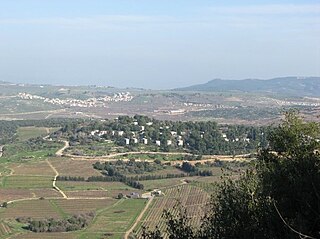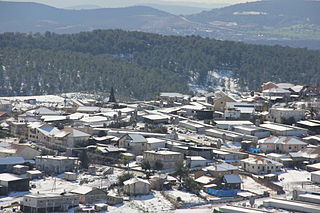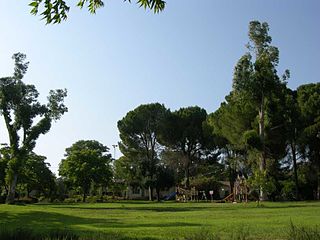
Iqrit was a Palestinian Christian village, located 25 kilometres northeast of Acre, in the western Galilee. In October 1948, the village's Palestinian Arab inhabitants were expelled by Zionist forces during the 1948 Palestine war, and the territory later became part of the new State of Israel. All of its Palestinian Christian inhabitants were forced to flee to Lebanon or the Israeli village of Rameh, and, despite the promise that they would be returned in two weeks' time, the villagers were not allowed to return, and the Israeli army destroyed the village.

Kafr ʿInān, is a former Palestinian village, depopulated in the 1948 Arab–Israeli war. It was located around 33 kilometres (21 mi) east of Acre.

Kiryat Shmona is a city in the Northern District of Israel on the western slopes of the Hula Valley near the Lebanese border. The city was named after the eight Jews, including Joseph Trumpeldor, who died in 1920 in the Battle of Tel Hai.

Adamit is a kibbutz in northern Israel. Located in the western Galilee in Israel near the border with Lebanon, it falls under the jurisdiction of Mateh Asher Regional Council. In 2022 it had a population of 286.

Sasa or Sassa is a kibbutz in the Upper Galilee area of northern Israel. Located one mile from the border with Lebanon, it falls under the jurisdiction of Upper Galilee Regional Council. In 2022 it had a population of 396.

Meron is a moshav in northern Israel. Located on the slopes of Mount Meron in the Upper Galilee near Safed, it falls under the jurisdiction of Merom HaGalil Regional Council.

Menara, popularly known as Manara, is a kibbutz in northern Israel. Located on the Ramim Ridge of the Naftali Mountains, Upper Galilee, adjacent to the Lebanese border and overlooking the Hula Valley, it falls under the jurisdiction of Upper Galilee Regional Council. In 2022 it had a population of 284.

Biranit is a military camp and former kibbutz in northern Israel on the border with Lebanon. It is the headquarters of the Galilee Division of the Israel Defense Forces, and is located around a kilometre from the Lebanese border between Sasa and Netu'a.

Kafr Bir'im, also Kefr Berem, was a former village in Mandatory Palestine, located in modern-day northern Israel, 4 kilometers (2.5 mi) south of the Lebanese border and 11.5 kilometers (7.1 mi) northwest of Safed. The village was situated 750 meters (2,460 ft) above sea level. "The village stood on a rocky hill only a little higher than the surrounding area and faced north and west."

Kfar Giladi is a kibbutz in the Galilee Panhandle of northern Israel. Located south of Metula on the Naftali Mountains above the Hula Valley and along the Lebanese border, it falls under the jurisdiction of Upper Galilee Regional Council. In 2022 it had a population of 702.

Lavi is a kibbutz in northern Israel. Located 310 meters above sea level and 10 minutes from Tiberias, it falls under the jurisdiction of Lower Galilee Regional Council. In 2022 it had a population of 604.

Birya is an agricultural village in northern Israel. Located in the Upper Galilee near Safed, it falls under the jurisdiction of the Merom HaGalil Regional Council. As of 2022 its population was 872.

The Kfar Bar'am Synagogue, also known as the Kafar Berem Synagogue, is the archaeological ruins of two former ancient Jewish synagogues, located at the site of Kafr Bir'im, a depopulated Palestinian village, in what is today, the Bar'am National Park, in the Galilee region of the Northern District of Israel, approximately 3 kilometres (1.9 mi) from the border with Lebanon. It is estimated that the former synagogue was completed in the 3rd century, during the Roman period, likely by c. 220 CE, and was located in the medieval Jewish village of Kfar Bar'am.

Dalton is a moshav near Safed in northern Israel under the jurisdiction of Merom HaGalil Regional Council. It was founded by immigrants from Tripoli in Libya in 1950 under the leadership of Hapoel HaMizrachi.

Dovev is a moshav in northern Israel. Located in the Upper Galilee around 7 km north of Har Meron near Israel's border with Lebanon, it falls under the jurisdiction of Merom HaGalil Regional Council. As of 2022 it had a population of 464.

Ma'ayan Baruch is a kibbutz in northern Israel. Located near the Lebanese border, it falls under the jurisdiction of Upper Galilee Regional Council. In 2022 it had a population of 746.

Bar'am National Park is a national park in Israel, between kibbutz Sasa and moshav Dovev, near the Lebanese border. On the grounds of the park is a synagogue from the Talmudic period, and the ruins of the depopulated Palestinian village of Kafr Bir'im, after which the park is named.
Maronites in Israel are an ethnoreligious minority who belong to the Maronite Catholic Church, which has historically been tied with Lebanon. They derive their name from the Syriac Saint Maron, whose followers moved to Mount Lebanon from northern Syria, establishing the Maronite Church, most of whose members currently reside in Lebanon. The Maronites in Israel encompass the long-existing Maronite community in Jish, Haifa, and Nazareth areas, as well as the families of former South Lebanon Army members, 7,000 of whom fled South Lebanon in April–May 2000 to Israel. Of these approximately 7,000 migrants, just 2,700 have remained in Israel: over the years, most of them have decided to either return home to Lebanon or to move to Europe or the United States.



















